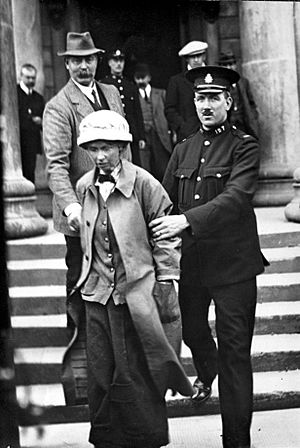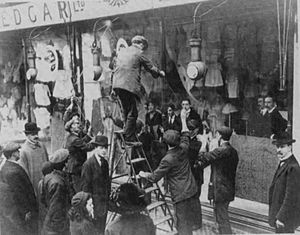Frances Parker facts for kids
Quick facts for kids
Frances Parker
OBE |
|
|---|---|

Parker being escorted from Ayr Sheriff Court by a police officer in 1914
|
|
| Born |
Frances Mary Parker
24 December 1875 Kurow, Otago, New Zealand
|
| Died | 19 January 1924 (aged 48) Arcachon, France
|
| Nationality | New Zealander |
| Alma mater | Newnham College, Cambridge |
| Occupation | Suffragette |
Frances Mary "Fanny" Parker (born December 24, 1875 – died January 19, 1924) was a brave suffragette from New Zealand. She became a very important leader in the Scottish movement that fought for women's right to vote. Because of her strong actions, she was put in prison many times.
Contents
Early Life and Education
Frances Mary Parker was born on December 24, 1875, in a place called Little Roderick, near Kurow, New Zealand. She was one of five children. Her family was quite wealthy, and she was even the niece of a famous military leader, Lord Kitchener.
It's interesting to know that women in New Zealand gained the right to vote on September 19, 1893. They voted for the first time in an election held on November 28, 1893.
In 1896, Fanny Parker left New Zealand to study at Newnham College, Cambridge in England. Her uncle helped pay for her studies. She finished her degree in 1899. After that, she worked as a teacher for several years in France and back in New Zealand.
Fighting for Women's Vote
When Fanny Parker returned to Britain, she started working hard for women's right to vote, also known as women's suffrage. At first, she gave speeches for the Scottish Universities Women's Suffrage Union. Later, she joined Emmeline Pankhurst's Women's Social and Political Union (WSPU). This group was known for its strong actions to get attention for their cause. In 1912, she became an organizer for the WSPU in western Scotland.
Strong Actions for Change
Fanny Parker took part in many powerful protests. She was sent to prison several times for these actions. In 1908, she spent six weeks in prison after a demonstration. In March 1912, she was sentenced to four months in Holloway Prison. This was after she joined other suffragettes in breaking windows as a form of protest.
While in prison, Fanny Parker and other suffragettes secretly sewed their names onto a piece of cloth. This cloth is now famous and known as The Suffragette Handkerchief. Like many suffragettes, she refused to eat while in prison, which is called a hunger strike. Because of this, she was sometimes made to eat by force.
Later in 1912, she was imprisoned two more times. Once for breaking windows, and another time for trying to stop a speech by a politician, David Lloyd George, in Aberdeen. Both times, she was released after refusing to eat for several days.
Protests and War
By 1914, the suffrage movement was using even stronger methods. Many buildings across Britain were being bombed or set on fire. In July 1914, Fanny Parker and another activist, Ethel Moorhead, tried to set fire to Burns Cottage in Alloway. This was the home of famous poet Robert Burns. A watchman was there, and while Ethel escaped, Fanny was caught.
While waiting for her trial, she refused to eat or drink. She wrote about the harsh way she was treated in prison in a newspaper called Votes for Women. She became very ill but managed to escape from a nursing home where she was being held.
The WSPU gave Fanny Parker a special Hunger Strike Medal for her bravery.
Before she could be caught again, the First World War began. This led to an end of the strong protests, and many suffragettes were set free.
During the war, Fanny Parker served in the Women's Army Auxiliary Corps. She was given an award called the OBE for her service. After the war, she lived in France, where she passed away in 1924. Fanny Parker left her Hunger Strike medal to her friend, Ethel Moorhead.
Legacy and Recognition
Fanny Parker's story continues to be remembered. In 2014, a play called CauseWay was written by Victoria Bianchi. It was based on Fanny Parker and Ethel Moorhead's attempt to set fire to Burns Cottage. The play was performed at the Robert Burns Birthplace Museum.
In 2016, the Museum of New Zealand Te Papa Tongarewa bought Fanny Parker's suffragette medal. This medal, the Women's Social and Political Union Medal for Valour, was bought from an auction in Scotland. It is now displayed at the museum in Wellington. It is believed to be the only suffragette medal with a connection to New Zealand.
The famous Suffragette Handkerchief, with Fanny Parker's embroidered signature and the names of 67 other suffragettes, can be seen at Priest House in West Hoathly, Sussex.
See also
 In Spanish: Frances Parker para niños
In Spanish: Frances Parker para niños


